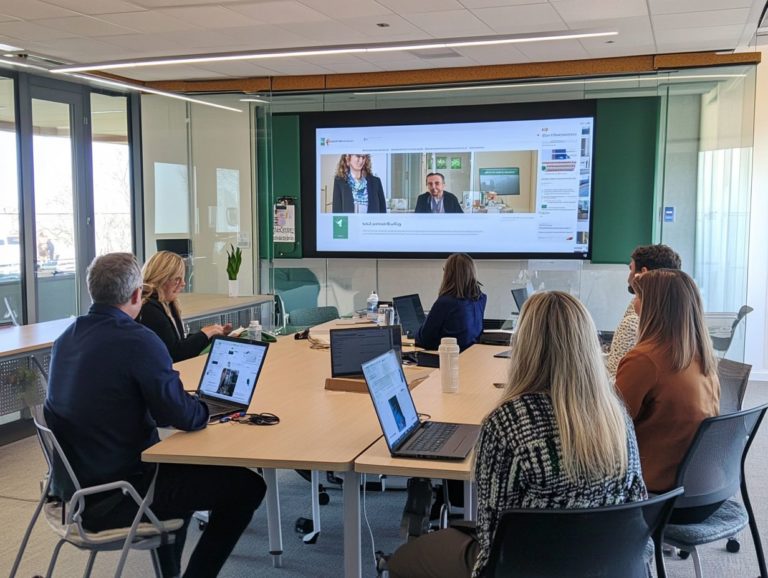What Is the Importance of Follow-Up Training?
In today s fast-paced work environment, you ll find that initial training sessions often fall short in guaranteeing long-term success and skill retention.
This article delves into the vital role of follow-up training, illustrating how it can effectively bridge knowledge gaps and enhance the application of the skills you’ve learned.
You ll discover effective implementation strategies, methods to measure the impact of follow-up training, and ways to navigate common challenges.
By the end, you ll grasp why follow-up training is indispensable for fostering a culture of continuous learning and improvement.
Contents
- Key Takeaways:
- The Importance of Follow-Up Training
- Benefits of Follow-Up Training
- How to Implement Effective Follow-Up Training
- Measuring the Impact of Follow-Up Training
- Overcoming Challenges in Follow-Up Training
- Common Obstacles and Solutions
- Frequently Asked Questions
- What is the Importance of Follow-Up Training?
- Why is it Necessary to Have Follow-Up Training?
- How Does Follow-Up Training Benefit Employees?
- What are the Benefits of Follow-Up Training for Employers?
- Is Follow-Up Training Only Necessary for New Employees?
- How Often Should Follow-Up Training Be Conducted?
Key Takeaways:

- Regular follow-up training helps employees retain and apply skills, leading to improved performance and productivity.
- Effective follow-up training addresses knowledge gaps and strengthens understanding of key concepts, ensuring employees have the necessary knowledge to perform their jobs effectively.
- Measuring the impact of follow-up training is crucial in determining its effectiveness and identifying areas for improvement in future training programs.
The Importance of Follow-Up Training
Follow-up training is essential for reinforcing the learning journey. It ensures you get the most out of the training program you ve participated in. It serves as a vital link between theoretical concepts and their effective application in your workplace, ultimately producing lasting effects on your individual performance and the overall success of the business.
Unlock your potential with continuous improvement! By maintaining regular engagement through tools like feedback surveys and one-on-one check-ins, organizations can cultivate your motivation and commitment to ongoing skill development. This approach not only enhances the effectiveness of the training but also ensures alignment with broader business objectives.
Defining Follow-Up Training
Follow-up training is a helpful tool in reinforcing knowledge retention and ensuring the practical application of the skills you’ve acquired during those initial training sessions.
This approach includes various methods, such as refresher courses, workshops, and personalized mentoring sessions. These are crafted to help you remember what you’ve learned and implement these skills effectively in real-world situations. The heart of follow-up training is its dedication to continuous improvement, cultivating an environment where ongoing learning is not just encouraged but celebrated.
By regularly assessing knowledge gaps and addressing these areas, organizations foster a culture of development vital for your growth and the overall success of the team. This process enables a thorough evaluation of training programs, allowing stakeholders to measure outcomes against established benchmarks, ensuring that the learning objectives are not only met but retained over time.
Benefits of Follow-Up Training
Engaging in follow-up training offers a wealth of benefits that can significantly enhance your organization’s dynamics. You’ll see increased employee engagement, improved performance levels, and better knowledge retention all critical elements for the successful implementation of training initiatives.
Investing in this approach not only cultivates a more skilled workforce but also fosters a culture of continuous improvement and learning.
Improving Retention and Application of Skills

One of the primary benefits of follow-up training is its remarkable ability to enhance knowledge retention and facilitate the successful application of the skills you’ve acquired during the initial training program.
By integrating ongoing training programs with practical assignments, you create an environment where employees feel genuinely supported in their development. These methodologies encourage mastery of new information and strengthen the connection between theoretical learning and real-world application.
Techniques like spaced learning where you revisit information over time and hands-on projects enable you to absorb knowledge more effectively. Incorporating feedback mechanisms refines the training process, ensuring it remains relevant and impactful, ultimately nurturing a culture of continuous improvement and skill application.
Implement follow-up training strategies in your organization to unlock the full potential of your workforce!
Addressing Knowledge Gaps
Effective follow-up training is vital for you to identify and address any knowledge gaps that might be holding back your performance and the overall productivity of your organization.
By utilizing performance assessments and feedback surveys, you can gain valuable insights into the areas where you might face challenges, allowing you to identify specific weaknesses.
Customized support, tailored to your individual or team needs, plays a crucial role in bridging these gaps, empowering you to enhance your skills and boost your confidence.
This proactive approach drives continuous improvement and nurtures a culture of learning and development in your workplace. Ultimately, when you feel supported on your growth journey, your overall job satisfaction increases, leading to a more motivated and engaged workforce.
How to Implement Effective Follow-Up Training
Implementing effective follow-up training demands a strategic approach that seamlessly weaves together engagement strategies, coaching techniques, and clear action plans. This ensures that employees receive the ongoing support they need after their initial training, empowering them to thrive and excel in their roles.
Key Components and Strategies
The key components of effective follow-up training for you include regular feedback surveys, open Q&A sessions, group discussions, and one-on-one check-ins. Each of these elements is designed to encourage open conversation between trainers and employees, ensuring that you remain engaged and informed.
These components are essential for maintaining a dynamic learning environment where you feel supported and valued. Regular feedback surveys allow trainers to assess your understanding and satisfaction, creating a platform for meaningful insights that benefit everyone involved.
Open Q&A sessions promote transparency, giving you the opportunity to voice concerns or seek clarification, which in turn enhances trust and engagement in the process.
Group discussions encourage collaboration and peer learning, both vital for reinforcing the concepts introduced during formal training. Meanwhile, one-on-one check-ins provide tailored support, ensuring that your unique challenges are addressed.
Together, these strategies create a cohesive training ecosystem that significantly boosts your retention and application of skills.
Measuring the Impact of Follow-Up Training

Measuring the impact of follow-up training is essential for grasping its effectiveness and ensuring a positive return on investment (ROI). This can be accomplished through robust training evaluation methods that provide insightful data and a clear understanding of outcomes.
Methods for Assessing Effectiveness
To accurately assess the effectiveness of follow-up training, you can employ various methods such as feedback surveys, performance assessments, and metrics that gauge training retention.
These approaches not only offer valuable insights into how well participants grasped and applied the training but also illuminate areas that may require enhancement. Feedback surveys allow trainees to share their thoughts on the content and delivery, fostering a culture of open communication.
Meanwhile, performance assessments help you measure the skills and knowledge that you can apply directly, ensuring that the training translates into real-world capabilities.
Together, these methods form a feedback loop that is essential for continuous improvement, empowering you to adapt and refine training programs for maximum impact.
Overcoming Challenges in Follow-Up Training
Despite its advantages, follow-up training can encounter several challenges that might hinder its effectiveness. However, by identifying these obstacles and implementing practical solutions, you can significantly enhance employee satisfaction and drive performance improvement.
Common Obstacles and Solutions
Navigating common obstacles in follow-up training can be quite a challenge. You might find that lack of employee engagement, inadequate custom support, and ineffective performance assessments stand in the way of achieving your desired outcomes.
These hurdles can lead to gaps in knowledge retention and application. Ultimately, this impacts workplace productivity and morale.
To combat disengagement, consider introducing interactive elements into your training sessions. Options like adding game-like features or tailored learning paths can resonate with individual career aspirations.
Creating a supportive environment through regular check-ins can make all the difference. Helping employees feel valued and understood enhances their overall experience.
Implementing a clear way to give and receive performance feedback helps create dynamic performance assessments. This approach builds a robust support network for continuous improvement.
Frequently Asked Questions

What is the Importance of Follow-Up Training?
Follow-up training is essential! It reinforces your knowledge, keeps you updated, and boosts your performance.
Why is it Necessary to Have Follow-Up Training?
Don t miss out on the benefits of follow-up training it ensures that information and skills learned are retained and applied in real-life situations.
It also helps address any gaps or areas of improvement that may have been missed during the initial training.
How Does Follow-Up Training Benefit Employees?
Follow-up training provides employees with the opportunity to enhance their skills and learn new techniques. It keeps them up-to-date with industry standards.
This not only boosts confidence and job satisfaction but also increases their value as employees.
What are the Benefits of Follow-Up Training for Employers?
Employers can reap many benefits from follow-up training. These include increased productivity, improved job performance, reduced employee turnover, and a more skilled workforce.
It also shows employees that the company values their professional growth and development.
Is Follow-Up Training Only Necessary for New Employees?
No! Follow-up training is beneficial for both new and existing employees.
New employees may need it to ensure they understand their job responsibilities, while existing employees can benefit from refresher courses or advanced training.
How Often Should Follow-Up Training Be Conducted?
The frequency of follow-up training depends on the specific industry, job role, and individual learning needs.
It can be conducted quarterly, annually, or as needed. Regular evaluations can help determine when follow-up training is necessary.






